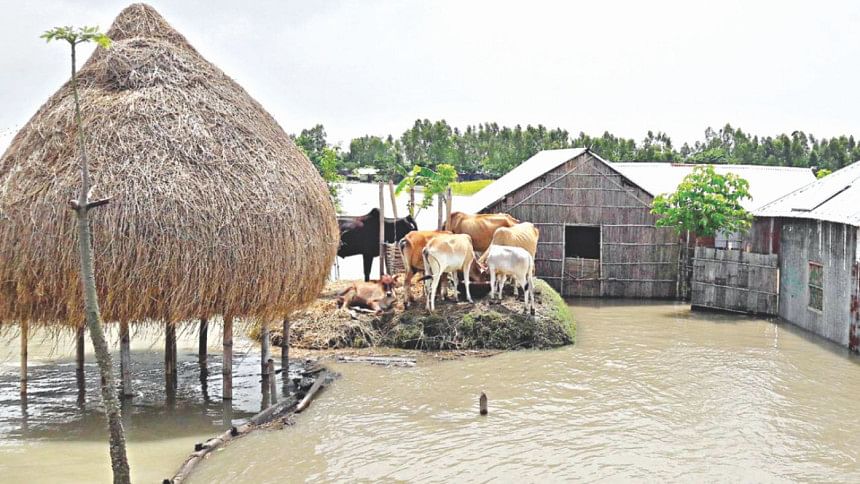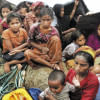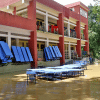Flood hits the North

Many low-lying areas of Sirajganj, Bogra, Gaibandha, Kurigram and Jamalpur were inundated yesterday as three major rivers witnessed a rise in water level due to heavy flow and rain.
The Indian state of Assam has been experiencing heavy floods for the last few days and its water is overflowing to Bangladesh through the Brahmaputra river, said Sazzad Hossain, executive engineer of Flood Forecasting and Warning Centre (FFWC) of the Water Development Board (WDB).
As a result, water level in the Brahmaputra and the Jamuna witnessed a rise that caused floods in the low-lying areas of the river basins, he told The Daily Star yesterday.
According to the Indian media reports, flood situation in Assam worsened on Friday, affecting around 4.5 lakh people in 17 districts. Three more people were killed, taking the death toll to 22, reports the Times of India yesterday.
The water level of the Teesta has meanwhile been increasing as most of the gates of India's Gajoldoba Barrage were left open, a WDB official said.
The flood situation in the Sylhet region saw little improvement yesterday as the water level in two major rivers -- the Surma and the Kushiyara -- flowing over the danger point showed a declining trend.
However, the situation might deteriorate again as the water level of the Kushiyara saw a rising trend last evening, Sirajul Islam, executive engineer of WDB in Sylhet, said.
According to the latest bulletin of FFWC, the Brahmaputra, Jamuna and Padma rivers were also showing a rising trend.
It also forecasted that the Jamuna might continue rising for the next 48 hours, while the Ganges-Padma rivers might continue rising for next 72 hours.
The Brahmaputra might remain steady in next 24 hours, while the Surma and the Kushiyara might witness a decline in next 48 hours, said the bulletin issued at 9:00am yesterday.
Of the 90 monitoring stations, water was flowing over the danger level at eight points, said the bulletin. The water level rose at 49 points and dropped at 33 points, two points remained steady and six points remained unreported, it added.
Sazzad, however, said the water level at the bordering monitoring stations saw a declining tread in their latest observation.
The Jamuna was flowing above the danger level at Bahadurabad, Sariakandi, Kazipara and Sirajganj points, while the Kushiyara, Surma and Kangsha were flowing above the danger mark at Amalshid, Sheola, Kanaighat and Jariajanjail points, the bulletin said.
In Sirajganj, huge areas of Kazipur, Chowhali and Shahzadpur upazilas were flooded in last 24 hours due to a rise in water level in the Jamuna. The floods inundated more than 100 villages of 25 unions in three upazilas.
Hasan Imam, executive engineer of the WDB, Sirajganj, said the floodwater submerged low-lying areas outside the embankment.
An around-70-metre-long stretch of the flood protection embankment in Chowhali upazila has meanwhile been eroded again. The Sirajganj town protection embankment has been kept on high alert to avoid damage.
The Jamuna was flowing one centimetre above the danger level on Friday, but the water level rose rapidly in last 24 hours. The Jamuna was flowing 15 centimetres above the danger level yesterday morning, Hasan added.
The water level may keep increasing for one week due to the heavy flow of water from the upstream, he said, adding that the Padma and the Teesta were overflowing, so there was no possibility of receding water level in the Jamuna immediately.
In Bogra, the low-lying areas of 15 villages in Shariakandi, Sonatola and Dhunat upazilas were inundated with the sudden rush of water. Around 5,000 people were marooned, upazila and WDB sources said.
Aush paddy on 1,060 hectares of land, crops on 1,900 hectares of land and 20 hectares of land for seedlings were inundated, the Department of Agricultural Extension sources said.
Mohammad Hossain, district primary education officer, said at least 15 primary schools in Shariakandi and four primary schools in Dhunat were closed.
Nur-e-Alam Siddiki, deputy commissioner of Bogra, said 70 tonnes of rice was allocated for Shariakandi and Sonatola upazilas.
In Kurigram, the overall flood situation worsened as water levels in the Brahmaputra, Dudhkumar, Dharla and Teesta rivers increased in last 24 hours.
According to local sources, about 65,000 people of char and lowland areas in nine upazilas of the district were marooned due to floodwater.
Ayub Ali, chairman of Jatrapur Union Parishad under Kurigram Sadar, said around 9,000 people were marooned and were facing fuel and cattle food crisis.
Civil Surgeon Dr Aminul Islam said 88 medical teams were formed for emergency treatment of the affected people.
In Gaibandha, more than 3,000 people were marooned in remote char areas of Gaibandha Sadar, Fulchhari and Shaghata upazilas as water level in the Brahmaputra basin rose.
A vast tract of cropland went under water as the Brahmaputra was flowing 12 centimetres above the danger mark yesterday. The Teesta, the Ghagot and the Karotoa might cross the danger mark as the water level continued to increase, according to WDB officials.
At least 15 points along the flood control dyke in Fulchhari and Shaghata upazila have been marked vulnerable and might collapse any time.
People of Balashi Ghat in Fulchhari formed a human chain demanding immediate measures to stop erosion and rehabilitate the flood victims.
In Jamalpur, flood situation worsened as the Jamuna swelled, with vast areas of low-lying land of 16 unions in Islampur, Dewanganj, Sharishabari and Melandah being affected by the flood. Around 40,000 people have been marooned, upazila administration officials said.
Of the affected unions, Kulkandi, Chinaduli, Belgachha, Sapdhari and Noarpara of Islampur upazila and Chukaibari and Hatibandha unions of Dewanganj have been hit badly.
Chairman of Chukaibari UP Selim Khan said around 5,000 people of his union were marooned and facing a shortage of drinking water and sanitation facilities.
Twenty-two primary schools and two high schools were declared closed due to the floods.
In Lalmonirhat, more than one lakh people living in the Teesta shoal areas were in fear as the water level was rising.
Most of the gates of India's Gajoldoba Barrage were kept open, resulting in a rise in water level downstream, said Mostafizur Rahman, executive engineer of WDB at Dalia.
Hatibandha upazila's Dawabari UP Chairman Rezzakul Islam said many char people started moving to safer places. If the Teesta water crossed the danger level, about 50 percent areas would be inundated, he added.
“Gajoldoba Barrage authorities will alert us if they faced a red alert situation. Then we will take an immediate step,” Mostafizur said.

 For all latest news, follow The Daily Star's Google News channel.
For all latest news, follow The Daily Star's Google News channel. 








Comments